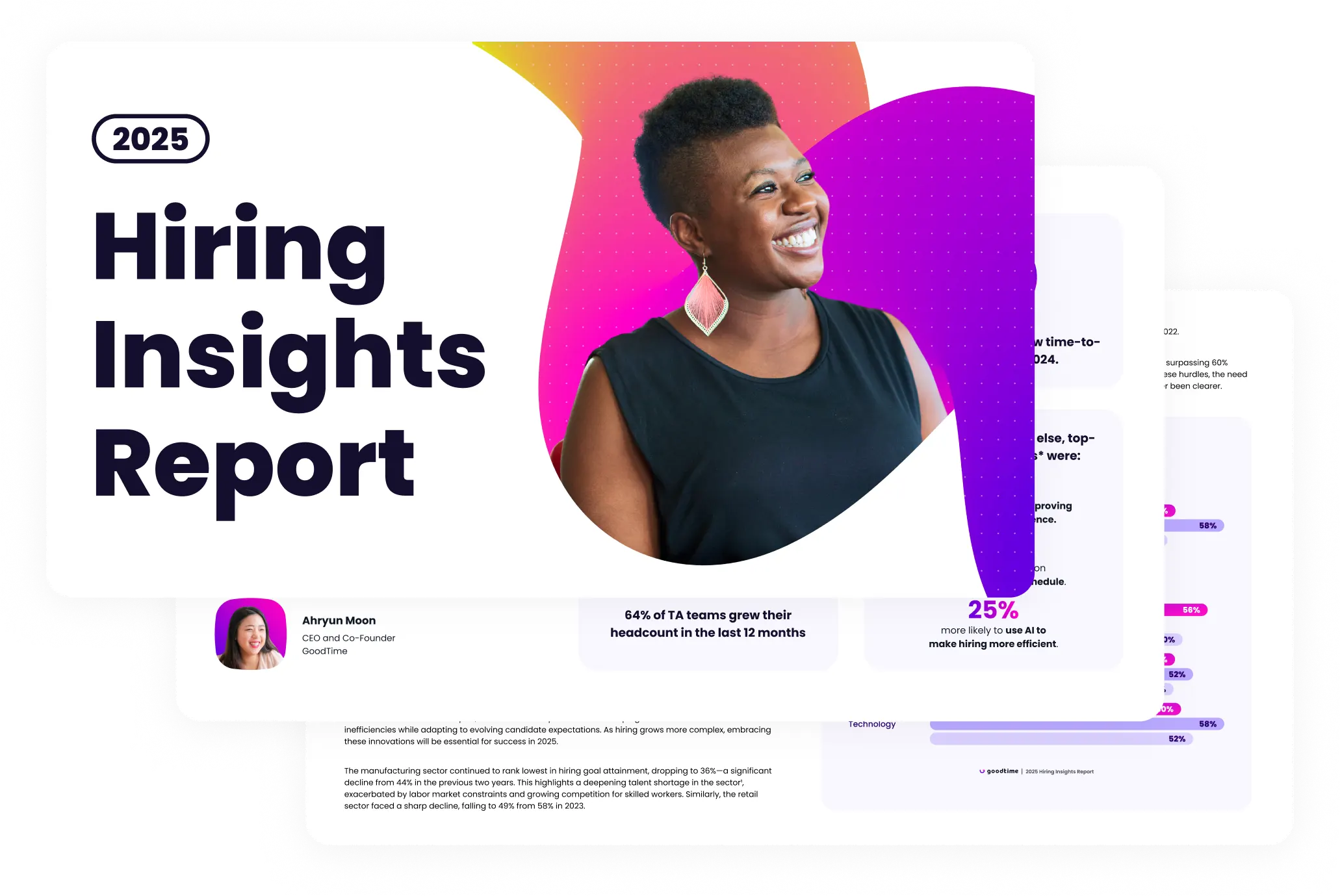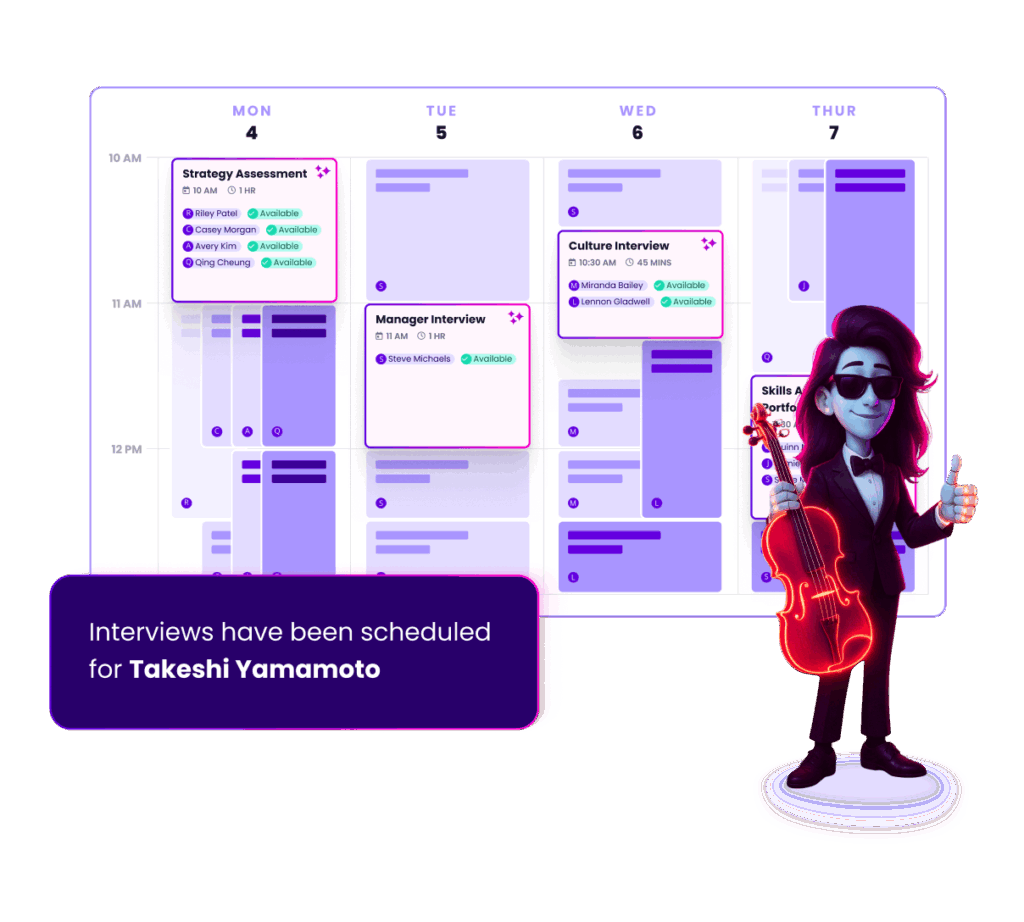Part of running a successful business is managing the employee lifecycle. But what is it exactly?
The employee lifecycle is the complete journey an employee experiences with their employer, from hiring to exit and beyond. Hiring and recruitment may get the most attention, but top business leaders know how important optimizing every phase in the employee lifecycle is. That’s one of the best ways to boost employee engagement and productivity in your workplace.
This guide will discuss best practices for employee lifecycle management at your business, including tips from HR experts in a YouTube discussion.

Unlock 2025’s top hiring strategies: Insights from 500+ TA leaders
Be the first to uncover deep hiring insights specific to your sector — straight from the highest-performing TA teams.

The key phases of the employee lifecycle
The employee lifecycle has more key phases than you might expect — seven in total. Let’s break down each phase so you know what to expect.
Attract
The first of the employee lifecycle phases occurs before you hire the workers and before they even apply. To staff your business with the best employees, you first need to attract top job candidates.
Job seekers often find many positions that might be a good fit. They have to decide which job listings are worth applying to based on the limited information they have about each job and employer. Your ability to attract the best job seekers to your company comes down to your employer brand.
An employer brand is the perception job seekers have of your company as a workplace. It includes your reputation as an employer, company culture, and values. The stronger your employer brand is, the easier it will be to get excellent candidates to want to work for you.
Recruiting
The next step is recruiting candidates. At this stage, you’re finding and evaluating candidates for your job opening. It’s time to determine who the best person for the job is through the interview process.
Start by thinking about what kind of candidates you want. Nearly 25% of talent acquisition teams report a lack of qualified candidates as a top hiring challenge. Beyond improving your employer brand, adjusting your job listing will also help you attract more qualified candidates for your job openings. A job listing for a senior-level role should look different in style and tone from an entry-level job listing.
Use inclusive language in your job listings by avoiding gender-coded words like “dominate” or “nurture” and unnecessary references to national origin. Over 90% of job seekers don’t finish some online job applications they start. If you want to make sure interested candidates complete your application, make the process as straightforward as possible.
Lotus Buckner, Founder and CEO at LB Talent Solutions, says, “Don’t just try to measure everything you see as HR metrics. Focus on what will give the biggest impact, and make sure to keep inclusion in mind as you develop your employee life cycle strategies.”
Once you have your list of candidates, you need to conduct interviews. Consider different interview styles and go through several rounds as necessary to identify your top choice for the job. Then, make an offer to that candidate. Remember to notify unsuccessful candidates about your decision so they’re not left in the dark.
Onboarding
So, you found the right person for the job, and they accepted your job offer. Now, you have to onboard your new employee. Onboarding is all about setting your new employees up for success in the role and integrating them into your organization.
Your new hires will need to fill out paperwork, get set up with your systems and technology, and receive some training on transitioning into their role. There’s also a personal element of onboarding — you should try to make your new employees feel as welcome as possible. Developing a sense of belonging will make them more effective in their roles.
Development
Learning doesn’t end with the onboarding phase. Even once your new hires are up to speed in their roles at your company, they can always learn something new.
As an employer, you should support your employees’ continuous learning and growth. When your employees further their professional development, your company also benefits. Your investment in employee development will likely pay off for your company’s productivity and employee satisfaction.
Reward and recognition
Some employers only point out when employees make mistakes or fail to meet expectations, but that is its own mistake. Instead of only calling out employees for negative things, emphasize their positive performance, too.
Take it one step further and reward those employees for their good work. Implementing a system of recognition and rewards makes your employees feel valued. They’ll be more engaged, loyal to your company, and more likely to perform at a high level.
Progress and perform
Employers need to evaluate their employees regularly and provide feedback. Many managers dread performance reviews, but they don’t need to be painful.
Instead, consider performance reviews an opportunity to check in and ensure that everyone is making progress toward their goals. You can offer actionable advice to employees to help them improve and acknowledge what they’re doing well. Also, ask employees to provide feedback on you as an employer. You might be missing something that you could change to make the workplace much better for your employees.
Retention and exit
The final stages of the employee lifecycle are retention and exit. Hiring top talent is great, but companies across industries often struggle to retain those great employees. Make adjustments to keep your best employees happy, including paying them fair wages for their growing skills and experience.
When people do leave the company, you need a clear offboarding process to make the transition as smooth as possible for both your organization and the exiting employees.
How to create a positive experience at every stage
Focus on optimizing each phase of the employee lifecycle to enhance employee satisfaction. Stephen Farber, the “Talent Retention Sherpa,” points out that “The ideal is that everybody joins and nobody leaves, right? But in every stage of that life cycle, we need to be playing to the employee experience, making sure it’s positive for the employee.”
Start by strengthening your employer brand. Ask current employees to review you as an employer on top websites like Glassdoor and LinkedIn. Make your company culture and values clear.
As you’re recruiting, try to simplify your hiring process. Using recruiting automation technology like GoodTime will help you reduce time-to-hire and optimize the recruitment process. During onboarding, use a checklist to ensure managers complete all the necessary tasks for your new employees.
Encourage employees to learn new skills, attend workshops, network with other professionals, or take courses for their professional development. When they perform well at work, acknowledge and reward them. Measure their progress and share feedback during regular performance reviews.
Don’t assume your best employees will automatically want to stay. You need to continually support them and make sure you’re a competitive employer for them. When employees do leave, use a smooth offboarding process to maintain those relationships.
Offboarding and maintaining relationships after exit
Your relationship with employees doesn’t have to end entirely when they leave your company. Top employers know that they should avoid burning bridges whenever possible and even take steps to maintain relationships with former employees. Those relationships could still serve your business well in the future.
For example, a former employee might eventually be interested in working for your company again. Or, they might refer someone they know for an open position in your workforce. These things can only happen if you end on a positive note and keep up good relationships with employees after they leave.
Implement a thoughtful offboarding process for when employees leave. Make sure employees have a clear timeline of what needs to happen before their last day, including completing paperwork, handing off their responsibilities, and doing the exit interview. Getting feedback from employees as they leave is crucial because you can get honest insights about how to improve your workplace and the organization as a whole.
As Latonya Howell, VP of People and Culture at Taffy, says, “If they leave and they’re still rooting for you as a company, still referring people, still have positive things to say — that’s a successful employee life cycle.”
Measuring success in employee lifecycle management
Tracking and reviewing concrete metrics will help you understand how well you manage the employee lifecycle. If some of these metrics aren’t as high as you’d like them to be, that’s a sign you should make some adjustments.
Consider employment and recruitment metrics like:
- Application completion rate: The percentage of candidates who complete your job application after starting it
- Offer acceptance rate: The percentage of candidates who say yes when you make them a job offer
- Time-to-hire: The time between when a candidate applies for your open job listing to when they accept your job offer
- Voluntary turnover rate: The percentage of employees who choose to leave your company over a given period
- Employee net promoter score (eNPS): The likelihood that an employee would recommend your organization as a place to work on a scale from 1 to 10
If you see these metrics improving, that’s a sign that your employee lifecycle management is effective.
Emily Kay, HR Director at Orange Recycling Services, says, “My goal isn’t necessarily that everyone stays and no one leaves. My goal is that while you’re there, you have a good experience, do good work, and if you leave, we launch you so well that you bring back people who want to start over.” Metrics like these will help you understand how well you achieve those goals.
Employee lifecycle FAQs
The employee lifecycle is the entire journey an employee experiences with a company, from hiring to exit and beyond.
The seven key phases are: Attract, Recruit, Onboard, Develop, Reward & Recognize, Progress & Perform, and Retain & Exit.
Managing every phase of the employee lifecycle improves employee engagement, productivity, and retention, helping build a stronger workforce and positive company culture.
Build a strong employer brand and create clear, inclusive job listings that highlight your company culture and values.
Make new hires feel welcome and set them up for success by providing training, integrating them into your team, and establishing a sense of belonging.
Supporting continuous learning and growth helps employees improve their skills, which boosts productivity and satisfaction at work.
Reward and recognize good performance, offer competitive compensation, and regularly provide feedback to keep employees engaged and committed.
Offboarding is the process of managing an employee’s exit. A smooth offboarding process maintains positive relationships, which could lead to future referrals or rehires.
The impact of a well-managed employee lifecycle
Many HR teams focus primarily on attracting and recruiting candidates, but that’s not even half the puzzle. To boost employee retention, productivity, and employer branding, focus on ensuring positive experiences at every stage of the employee lifecycle.
Rely on AI-powered interview management technology like GoodTime to optimize your employee lifecycle even further.
Upgrade your hiring journey with AI
GoodTime’s AI agents orchestrate the entire hiring journey — screening, scheduling, messaging, and more — so talent teams hire faster with a better candidate experience.





